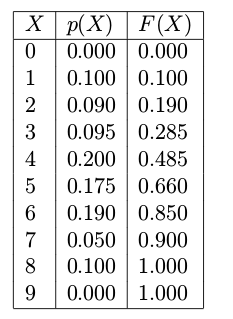MCMC and Bayesian Data Analysis(PPT在文件模块)
How to generate a sample from $p(x)$?
Let's first see how Matlab samples from a $p(x)$. In Matlab, there are several common probability distributions.

Try univariate Gaussian distribution
p= normpdf(linspace(xmin , xmax , num_of_points) , mean, standard_deviation);%PDF
c= normcdf(linspace(xmin , xmax , num_of_points) , mean, standard_deviation);%CDF
y=normrnd(mean, standard_deviation,number_of_samples, 1);%Random Number Generating Method
Try PDF:
x=linespace(-1,1,1000);
p=normpdf(x ,0, 1);
plot(x,p);
Note: linespace returns a vector which is usually accessed like this
x(1)%the first elem, not x(0)
x(:)
x(1,:)
Try RSM:
y=normrnd(0, 1,100, 1);%试试采10000个样本
hist( y , 20 );%20 bars
Try univariate uniform distribution
p= unifpdf(linspace(xmin , xmax , num_of_points) , a,b);%PDF
c= unifcdf(linspace(xmin , xmax , num_of_points) , a,b);%CDF
y=unifrnd(a,b,number_of_samples, 1);%RNG
Try PDF:
x=linespace(-10,10,1000);
p= unifpdf(x ,-5,5);
plot(x,p);
Try RSM:
y=unifrnd(-5, 5,100, 1);%试试采10000个样本
hist( y , 20 );%20 bars
Matlab provides random number generating functions for some standard $p(x)$, it doesn't provide us sampling functions for a general $p(x)$. Here I show some common sampling methods.
Inverse Transform Sampling(ITS)
with descret variables
This method generates random numbers from any probability distribution given the inverse of its cumulative distribution function. The idea is to sample uniformly distributed random numbers (between 0 and 1) and then transform these values using the inverse cumulative distribution function(InvCDF)(which can be descret or continous). If the InvCDF is descrete, then the ITS method just requires a table lookup, like shown in Table 1.

Table 1. Probability of digits observed in human random digit generation experiment
There is a method called randsample in Matlab that can implement the sampling process using the Table 1. See the code below.
%Note: The randsample doesn't defaultly exist in Octave-core package, install statistic package from http://octave.sourceforge.net/statistics/ before using randsample. % probabilities for each digit
theta=[0.000; ... % digit 0
0.100; ... % digit 1
0.090; ... % digit 2
0.095; ... % digit 3
0.200; ... % digit 4
0.175; ... % digit 5
0.190; ... % digit 6
0.050; ... % digit 7
0.100; ... % digit 8
0.000]; seed = 1; rand( 'state' , seed );% fix the random number generator
K = 10000;% let's say we draw K random values
digitset = 0:9;
Y = randsample(digitset,K,true,theta);
figure( 1 ); clf;
counts = hist( Y , digitset );
bar( digitset , counts , 'k' );
xlim([-0.5 9.5]);
xlabel( 'Digit' );
ylabel( 'Frequency' );
title( 'Distribution of simulated draws of human digit generator' );
pause;
Instead of using the built-in functions such as randsample or mnrnd, it is helpful to consider how to implement the underlying sampling algorithm using the inverse transform method which is:
(1) Calculate $F(X)$.
(2) Sample u from Uniform(0,1).
(3) Get a sample $x^{i}$ of $P(X)$, which is $F(u)^{-1}$.
(4) Repeat (2) and (3) until we get enough samples.
Note: For discrete distributions, $F(X)^{-1}$ is discrete, the way to get a sample $x^{i}$ is illustrated below where $u=0.8,~x^{i}=6$ .

with continuous variables
This can be done with the following procedure:
(1) Draw U ∼ Uniform(0, 1).
(2) Set $X=F(U)^{-1}$
(3) Repeat
For example, we want to sample random numbers from the exponential distribution where its CDF is F (x|λ) = 1 − exp(−x/λ) . Then $F(u|\gamma)^{-1}=-log(1-u)\gamma$. Therefore replace $F(U)^{-1}$ with $F(u|\gamma)^{-1}$.
p=-log(1-unifrnd(0,1,10000,1))*2;
hist(p,30);
Reject Sampling
Applied situation: impossible/difficult to compute CDF of $P(X)$.
Advantage: unlike MCMC, it doesn't require of any “burn-in” period, i.e., all samples obtained during sampling can immediately be used as samples from the target distribution $p(\theta)$.

Based on the Figure above, the method is:
(1) Choose a proposal distribution q(θ) that is easy to sample from.
(2) Find a constant c such that cq(θ) ≥ p(θ) for all θ.
(3) Draw a proposal θ from q(θ).
(4) Draw a u from Uniform[0, cq(θ)].
(5) Reject the proposal if u > p(θ), accept otherwise. Actually, since u is sampled from Uniform[0, cq(θ)], it is equal to state like this " Reject if $u\in[p(\theta),cq(\theta)]$, accept otherwise".
(6) Repeat steps 3, 4, and 5 until desired number of samples is reached; each accepted sample $\theta$ is a draw from p(θ).
For example

then the code is
k=100000;%draw k samples
c=2;
theta_vec=unifrnd(0,1,k,1)%gen a proposal vector from q($\theta$)
cq_vec=c*unifpdf(theta_vec);%cq(theta) vector
p_vec=2*theta_vec;%p(theta) vector
u_vec=[];
for cq=cq_vec
u_vec=[u_vec;unifrnd(0,cq)];
end
r=theta_vec.*(u_vec<p_vec);
r(r==0)=[];%remove the “0” elements
hist(r,20);

MCMC Sampling
Before getting to know MCMC sampling, we first get to know Monte Carlo Integration and Markov Chain.



For example:
%Implement the Markov Chain involving x under Beta(200(0.9x^((t-1))+0.05),200(1-0.9x^((t-1)-0.05))
fa=inline('','x')%parameter a for beta
fb=inline('200*(1-0.9*x-0.05)','x');%parameter b for beta
no4mc=4;%4 markove chains
states=unifrnd(0,1,1,no4mc);%initial states
N=1000;%200 samples drawn from 4 chains
X=states;
for i=1:N
states=betarnd(fa(states),fb(states));
X=[X;states];
end;
plot(X);
pause;

Metroplis Sampling
MCMC and Bayesian Data Analysis(PPT在文件模块)的更多相关文章
- 《利用Python进行数据分析: Python for Data Analysis 》学习随笔
NoteBook of <Data Analysis with Python> 3.IPython基础 Tab自动补齐 变量名 变量方法 路径 解释 ?解释, ??显示函数源码 ?搜索命名 ...
- 深入浅出数据分析 Head First Data Analysis Code 数据与代码
<深入浅出数据分析>英文名为Head First Data Analysis Code, 这本书中提供了学习使用的数据和程序,原书链接由于某些原因不 能打开,这里在提供一个下载的链接.去下 ...
- 数据分析---《Python for Data Analysis》学习笔记【04】
<Python for Data Analysis>一书由Wes Mckinney所著,中文译名是<利用Python进行数据分析>.这里记录一下学习过程,其中有些方法和书中不同 ...
- 数据分析---《Python for Data Analysis》学习笔记【03】
<Python for Data Analysis>一书由Wes Mckinney所著,中文译名是<利用Python进行数据分析>.这里记录一下学习过程,其中有些方法和书中不同 ...
- 数据分析---《Python for Data Analysis》学习笔记【02】
<Python for Data Analysis>一书由Wes Mckinney所著,中文译名是<利用Python进行数据分析>.这里记录一下学习过程,其中有些方法和书中不同 ...
- 数据分析---《Python for Data Analysis》学习笔记【01】
<Python for Data Analysis>一书由Wes Mckinney所著,中文译名是<利用Python进行数据分析>.这里记录一下学习过程,其中有些方法和书中不同 ...
- Aspose是一个很强大的控件,可以用来操作word,excel,ppt等文件
Aspose是一个很强大的控件,可以用来操作word,excel,ppt等文件,用这个控件来导入.导出数据非常方便.其中Aspose.Cells就是用来操作Excel的,功能有很多.我所用的是最基本的 ...
- 《python for data analysis》第五章,pandas的基本使用
<利用python进行数据分析>一书的第五章源码与读书笔记 直接上代码 # -*- coding:utf-8 -*-# <python for data analysis>第五 ...
- 《python for data analysis》第四章,numpy的基本使用
<利用python进行数据分析>第四章的程序,介绍了numpy的基本使用方法.(第三章为Ipython的基本使用) 科学计算.常用函数.数组处理.线性代数运算.随机模块…… # -*- c ...
随机推荐
- performSelector和respondsToSelector用法
一.performSelector调用和直接调用区别 下面两段代码都在主线程中运行,我们在看别人代码时会发现有时会直接调用,有时会利用performSelector调用,今天看到有人在问这个问题,我便 ...
- python基础知识3——基本的数据类型2——列表,元组,字典,集合
磨人的小妖精们啊!终于可以归置下自己的大脑啦,在这里我要把--整型,长整型,浮点型,字符串,列表,元组,字典,集合,这几个知识点特别多的东西,统一的捯饬捯饬,不然一直脑袋里面乱乱的. 一.列表 1.列 ...
- python 字符编码 转换
#!/bin/env python#-*- encoding=utf8 -*-# 文件头指定utf8编码还是乱码时,使用下面方式指定# fix encoding problem import sys ...
- nodejs+mysql
接着上一篇的php+mysql,我们来试一试nodejs怎么实现数据的增删查改. Node.js 是一个基于 Chrome V8 引擎的 JavaScript 运行环境.Node.js 使用了一个事件 ...
- Python语法二
1.raw_input 输入 2.如果想查看某个关键字的用法,可以在命令行输入pydoc raw_input. 如果是windows,那么试一下 python -m pydoc raw_input 3 ...
- 对病毒Virus.Win32.Ramnit.B的研究
- 文本换行word-wrap、word-break与white-space
本文同步至微信公众号:http://mp.weixin.qq.com/s?__biz=MzAxMzgwNDU3Mg==&mid=401671055&idx=1&sn=b88c9 ...
- 9.5.8 Optimizing InnoDB Disk I/O
如果你数据库设计以及sq操作都是最佳实践,但是你数据库仍然被较重的io活动拖累的较慢,那么试一试看看top或者windows的任务管理器,cpu使用率和工作量低于70%,那么或许是您的硬盘较慢. 1 ...
- sqllite
public static void tt() { int ID = 0; while(true) { stri ...
- windows 安装mysql 步骤
Windows 安装mysql 5.7.12教程 1.在官网下载mysql5.7.12.zip并解压 复制默认配置文件my-default.ini,并命名为my.ini 使用记事本打开,修改如下配置 ...
